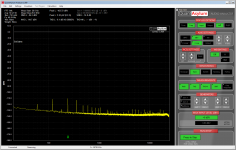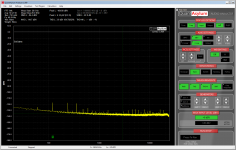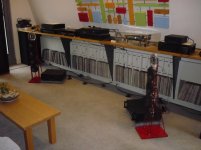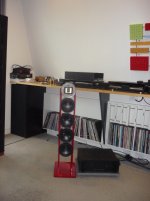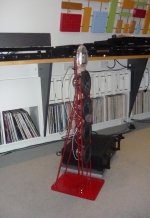JBL Studio 590 + SVS SB-1000 subwoofer
Initial tests are usually done with synth/electronic music, e.g. New Order's "Blue Monday".
For final tests usually play Vivaldi's "Four Seasons".
Mostly I listen to classical music.
Music plays from lossless files (dsf/flac) from my PC, via Schiit Modi DAC directly to power amp(s).
In living room, for watching movies, I use smaller Monitor Audio Bronze 2 speakers, and older Energy subwoofer.
Initial tests are usually done with synth/electronic music, e.g. New Order's "Blue Monday".
For final tests usually play Vivaldi's "Four Seasons".
Mostly I listen to classical music.
Music plays from lossless files (dsf/flac) from my PC, via Schiit Modi DAC directly to power amp(s).
In living room, for watching movies, I use smaller Monitor Audio Bronze 2 speakers, and older Energy subwoofer.
Last edited:
Minek!
The sound depends on many reasons.
1. The quality of the original recording and the intention of the sound engineer.
2. The quality of the audio path is determined by the worst link. In your case, perhaps a loudspeaker. In a broad sense, the technical characteristics, placement, properties of the room.
A good amplifier does not affect the sound. Or it affects only slightly. Therefore, the difference between the amplifiers is insignificant 🙂 Only gross defects are noticeable.
3. You correctly noted that mood, fatigue and other life situations affect. The perception of sound is a physiological but also psychological process. Sound recording and sound reproduction are objectively far from reality, the brain fills in the gaps.
I think you are right on all counts.
JBL Studio 590 + SVS SB-1000 subwoofer
Initial tests are usually done with synth/electronic music, e.g. New Order's "Blue Monday".
For final tests usually play Vivaldi's "Four Seasons".
Mostly I listen to classical music.
Music plays from lossless files (dsf/flac) from my PC, via Schiit Modi DAC directly to power amp(s).
In living room, for watching movies, I use smaller Monitor Audio Bronze 2 speakers, and older Energy subwoofer.
minek123,
Those look like nice speakers. Aren't you going to build a set of DIY speakers some time? Looks like you already have a nice collection of DIY amps. 😀
Also like you choice of tracks (Blue Monday and Four Seasons). 🙂
Music plays from lossless files (dsf/flac) from my PC, via Schiit Modi DAC directly to power amp(s).
Small question - how do you handle (remote?) volume control with this setup?
>Small question - how do you handle (remote?) volume control with this setup?
I don't.
It's a small room, I usually sit behind my desk with PC right there 🙂
>Aren't you going to build a set of DIY speakers some time?
I just discovered that it doesn't make sense to build amplifiers, now you want me
to come to the same conclusion with speakers ? 🙂 🙂
I don't.
It's a small room, I usually sit behind my desk with PC right there 🙂
>Aren't you going to build a set of DIY speakers some time?
I just discovered that it doesn't make sense to build amplifiers, now you want me
to come to the same conclusion with speakers ? 🙂 🙂
Many thanks Minek for frank answers........
There are moments when I agree with you 100%, but then, when I change an amp, I always feel small differences.
I think we design/built/listen because we like the process. The rest is perception and conjecture, and it is ludicrous to be objective about the subjective.
HD
There are moments when I agree with you 100%, but then, when I change an amp, I always feel small differences.
I think we design/built/listen because we like the process. The rest is perception and conjecture, and it is ludicrous to be objective about the subjective.
HD
Minek,
I think you may have measurement/layout issues. Are you using single ended or balanced connections with your QA401?
Suggestions
1. Use balanced connections from your load to the QA401 as a minimum
2. Twist the speakers cables to the load together.
3. For the balanced inputs from the load to the QA401, twist the wires together ( ie hot and cold). Bundle the speaker cables and the cables going to the QA401 tightly together
4. Keep any mains cabling well away from the speaker, input and output interconnects
5. You can get significant noise reduction by connecting the QA401 housing to the amplifier chassis - twist this cable around the output cables from the QA401 to the amplifier inputs
6. As already mentioned earlier, run your computer off batteries and make sure the adaptor is unplugged from the wall ( I think some of your hash is from an SMPS somewhere)
7. You MAY get a further few dB noise reduction by running a cable from the USB connector shroud to the QA401 housing. Wrap this cable around the USB cable.
You will need to play around with your set-up to get the optimal results - this is quite a steep learning curve.
You are using dBV measurements so all signals are referenced to 1V. This is a pretty brutal standard to set yourself. It is more normal to set the reference to dBR. To do this, drive the amplifier to full rated output in dBV mode ( usually this is the 1% distortion output). Then click on the dBR button and select ‘set peak output to 0 dB’ dialog box. This will then give you readings referenced to full output.
(I’ll try to post a video later this week - bit tied up at the minute. )
I think you may have measurement/layout issues. Are you using single ended or balanced connections with your QA401?
Suggestions
1. Use balanced connections from your load to the QA401 as a minimum
2. Twist the speakers cables to the load together.
3. For the balanced inputs from the load to the QA401, twist the wires together ( ie hot and cold). Bundle the speaker cables and the cables going to the QA401 tightly together
4. Keep any mains cabling well away from the speaker, input and output interconnects
5. You can get significant noise reduction by connecting the QA401 housing to the amplifier chassis - twist this cable around the output cables from the QA401 to the amplifier inputs
6. As already mentioned earlier, run your computer off batteries and make sure the adaptor is unplugged from the wall ( I think some of your hash is from an SMPS somewhere)
7. You MAY get a further few dB noise reduction by running a cable from the USB connector shroud to the QA401 housing. Wrap this cable around the USB cable.
You will need to play around with your set-up to get the optimal results - this is quite a steep learning curve.
You are using dBV measurements so all signals are referenced to 1V. This is a pretty brutal standard to set yourself. It is more normal to set the reference to dBR. To do this, drive the amplifier to full rated output in dBV mode ( usually this is the 1% distortion output). Then click on the dBR button and select ‘set peak output to 0 dB’ dialog box. This will then give you readings referenced to full output.
(I’ll try to post a video later this week - bit tied up at the minute. )
Last edited:
I just discovered that it doesn't make sense to build amplifiers, now you want me
to come to the same conclusion with speakers ? 🙂 🙂
Yes, you'll make better speakers that will let you hear the differences in your amplifiers 🙂
Thanks Bonsai!
> Use balanced connections from your load to the QA401 as a minimum
I do. See this post.
>Twist the speakers cables to the load together.
Cables between speakers and the load are only 10 inches long.
Cables connecting load to qa401 are only 1 foot long.
They sit next to each other.
But I guess, even though they are so short, still can be twisted.
>Keep any mains cabling well away from the speaker, input and output interconnects.
They are far away. No mains nearby.
>You can get significant noise reduction by connecting the QA401 housing to the amplifier chassis - twist this cable around the output cables from the QA401 to the amplifier inputs
This I will try.
I highly doubt any amp cabling is an issue here - because - even WITHOUT an amp and without any cables - just qa401 connected to usb port, noise level is already there (at approx 120 dB) - even with shorted balanced inputs, and looks the SAME with amp connected and powered (but without signal).
USB wiring can be a different story..
>As already mentioned earlier, run your computer off batteries and make sure the adaptor is unplugged from the wall ( I think some of your hash is from an SMPS somewhere)
Tried that long time ago. I run it from desktop PC. This was my 1st suspect.
Tested with laptop (running from batteries) with exactly same results.
There is plenty of SMPS around; e.g. amp fan is powered from small spms or buck converters in some cases.
Tried without fans/smps/converters connected. No difference.
There is also another 10 or so small/crappy smps-es within 6 feet, powering all kinds of little things (phones, routers, switches, etc..).
>You MAY get a further few dB noise reduction by running a cable from the USB connector shroud to the QA401 housing. Wrap this cable around the USB cable.
Will try. I also tried with/without USB optical separator - I use it between DAC and PC, works great. But unfortunately didn't make any diff for qa401.
>You will need to play around with your set-up to get the optimal
results - this is quite a steep learning curve.
I'm playing with this thing already for months. This is the best I could do so far. I tried all obvious things.
>You are using dBV measurements so all signals are referenced to 1V.
You wrote about dBr previously but I was confused by the settings, and statements from qa401 user guide saying that "dBr mode is for more 'esoteric' measurements" and advising to stay away from it 🙂
Can you refer to post #1578 regarding dynamic range of qa401?
If the official noise floor in the specs is 113dB, how can we expect anything better than I already see in my plots?
Or my understanding of 'noise floor' is wrong?
This of course doesn't explain ugly spikes present in my plots.. Just the bottom level.
> Use balanced connections from your load to the QA401 as a minimum
I do. See this post.
>Twist the speakers cables to the load together.
Cables between speakers and the load are only 10 inches long.
Cables connecting load to qa401 are only 1 foot long.
They sit next to each other.
But I guess, even though they are so short, still can be twisted.
>Keep any mains cabling well away from the speaker, input and output interconnects.
They are far away. No mains nearby.
>You can get significant noise reduction by connecting the QA401 housing to the amplifier chassis - twist this cable around the output cables from the QA401 to the amplifier inputs
This I will try.
I highly doubt any amp cabling is an issue here - because - even WITHOUT an amp and without any cables - just qa401 connected to usb port, noise level is already there (at approx 120 dB) - even with shorted balanced inputs, and looks the SAME with amp connected and powered (but without signal).
USB wiring can be a different story..
>As already mentioned earlier, run your computer off batteries and make sure the adaptor is unplugged from the wall ( I think some of your hash is from an SMPS somewhere)
Tried that long time ago. I run it from desktop PC. This was my 1st suspect.
Tested with laptop (running from batteries) with exactly same results.
There is plenty of SMPS around; e.g. amp fan is powered from small spms or buck converters in some cases.
Tried without fans/smps/converters connected. No difference.
There is also another 10 or so small/crappy smps-es within 6 feet, powering all kinds of little things (phones, routers, switches, etc..).
>You MAY get a further few dB noise reduction by running a cable from the USB connector shroud to the QA401 housing. Wrap this cable around the USB cable.
Will try. I also tried with/without USB optical separator - I use it between DAC and PC, works great. But unfortunately didn't make any diff for qa401.
>You will need to play around with your set-up to get the optimal
results - this is quite a steep learning curve.
I'm playing with this thing already for months. This is the best I could do so far. I tried all obvious things.
>You are using dBV measurements so all signals are referenced to 1V.
You wrote about dBr previously but I was confused by the settings, and statements from qa401 user guide saying that "dBr mode is for more 'esoteric' measurements" and advising to stay away from it 🙂
Can you refer to post #1578 regarding dynamic range of qa401?
If the official noise floor in the specs is 113dB, how can we expect anything better than I already see in my plots?
Or my understanding of 'noise floor' is wrong?
This of course doesn't explain ugly spikes present in my plots.. Just the bottom level.
Last edited:
Here are 3 examples of 'noise floor':
1) no amp connected, no cables plugged, diff input shorted by paper clip
2) no amp connected, 8.8 Ohm load connected (diff input), cables twisted
3) no amp connected, 8.8 Ohm load connected (diff input), cables twisted, AND ground of the load (diff -) connected to the chassis of qa401
1) no amp connected, no cables plugged, diff input shorted by paper clip
2) no amp connected, 8.8 Ohm load connected (diff input), cables twisted
3) no amp connected, 8.8 Ohm load connected (diff input), cables twisted, AND ground of the load (diff -) connected to the chassis of qa401
Attachments
What are your external gains?
To short the QA402 inputs, the best solution is to buy BNC sporting plugs off Amazon. They are about $3 a pop.
On an averaged dBV trace, the noise trace should show no noise spikes.
The spot noise floor (that’s the noise at a specific point in the measurement window and usually taken as 1 Hz BW) with the inputs shorted, no external gains, 50 averages and 20 kHz measurement BW should be about -150 to -155 dBV. If you integrate this noise over the measurement BW and do not average it, the total noise is specified -113 dBV. To read the noise accurately you must tick the ‘rtHz’ box in the dBV dialog box (note carefully the caveats associated with this wrt reading signal peaks in the manual - so only tick this box when you want to measure noise).
To short the QA402 inputs, the best solution is to buy BNC sporting plugs off Amazon. They are about $3 a pop.
On an averaged dBV trace, the noise trace should show no noise spikes.
The spot noise floor (that’s the noise at a specific point in the measurement window and usually taken as 1 Hz BW) with the inputs shorted, no external gains, 50 averages and 20 kHz measurement BW should be about -150 to -155 dBV. If you integrate this noise over the measurement BW and do not average it, the total noise is specified -113 dBV. To read the noise accurately you must tick the ‘rtHz’ box in the dBV dialog box (note carefully the caveats associated with this wrt reading signal peaks in the manual - so only tick this box when you want to measure noise).
Last edited:
The amp sounds great.
I measured several amps in the last month - basically most of the amps I built within last 3 years.
From these several amps I measured:
1) In listening test I can't tell them apart. They ALL sound the same to my tin ears (same PSU, same speakers, same DAC, same music)
I feel obliged to comment on your "findings", minek - because mine are very different. 🙂 (Possibly because I don't keep rotating amps ... I build a new one, confirm (with a listening team!) that it sounds better than the previous one - and get rid of the previous one! 🙂 )
I've done this over many years with Hugh's amps, driving my 3-way active Maggies; AKSA 100N+ plus two 55N+s gave way to a Soraya 100 plus two Lifeforce 55s ... which gave way to a Soraya 100 plus two NAKSA 80s.
A few months ago, having finished building two AN 4Rs to drive the 3ohm mids & 2ohm ribbons of my Maggies, Hugh came over for a listen. I myself "thought" the Maggies sounded better than with the NAKSAs ... but it was a close call. So I was a bit disappointed at having spent so much money and so much effort building these amps.
Today, Hugh came over again ... to listen to the AN 4Rs driving the new spkrs I had designed - which have replaced my Maggies.
He was blown away by how the AN4 Rs sounded with the new spkrs - so much better than with the Maggies. 🙂 We listened to a 'Test' CD of his that he knew well - and Hugh said that he was hearing stuff on the CD for the first time! 😎
So resolving spkrs would appear to be an essential part of comparing amps.
In case anyone is interested, below are pics of my new "zero baffle" spkrs. They:
* are 2-way active
* hand over to my subs at about 150Hz (still playing with that)
* use SB Acoustics 'Satori' drivers, and
* need a miniDSP or DEQX to provide the 24dB XOs and some mid/bass driver EQ.
Andy
Attachments
Nice setup Andy !
That are the new textreme drivers
Which AMT did you use ?
Have you tried a semi active setup ?
Active XO only for the sub and passive to the mids+AMT?
The passive filter can be a simple high pass filter between preamp and Nirvana amp
That are the new textreme drivers

Which AMT did you use ?
Have you tried a semi active setup ?
Active XO only for the sub and passive to the mids+AMT?
The passive filter can be a simple high pass filter between preamp and Nirvana amp
Nice setup Andy !
That are the new textreme drivers
Thank you, Danny.
Yes the 6 1/2" Textremes (MW16TX-4).
Which AMT did you use ?
The Satori AT60NC-4
Have you tried a semi active setup ?
Active XO only for the sub and passive to the mids+AMT?
The passive filter can be a simple high pass filter between preamp and Nirvana amp
No - not interested in passive XOs. I like amps directly connected to the drivers. 🙂
Andy
why 4 texTrene driver ? only ones do mid ....
My original design had just one mid/bass driver.
But because of the lack of baffle ... there was a huge hole from 500Hz down to 150Hz (where the subs take over).
Two drivers helped - but I still had to use a lot of EQ. Four drivers improved the situation (but adding significantly to the cost) ... so that I now use only a small amount of EQ. (A low-shelf boost and a high-shelf cut.)
Andy
Subjectives........ harump......
I'm never happy about subjectives. Everyone has a different opinion, and no one is any the wiser for a team of listeners after hours of varied tracks.
Until today. I have watched Andy's system evolve over more than 15 years. I have never met Andy's match for perseverance, thoughtful spending, and very good workmanship. He is meticulous and should be running Jay Leno's car collection..... We share very similar music too; a real diversity of jazz, pop, folk, reggae, electronica and of course a lot of classical, much on vinyl. Andy is very well organised and can catalogue everything he owns, and what changes have come and gone in time.
I was amazed to see that he has moved away from Maggies to a quartet of line array, open baffle Satori Textremes, each of 6.5" rated at 4R. In parallel/series he drives 4R loads, and the SB Acoustic ribbon, with four channels of Alpha Nirvanas and a couple of beefy sub-woofers driven by a pair of Class AB Soraya CB105. I designed all these amps, and lately reworked the AN for 4R loads to suit this precise speaker system.
The living soundscape I was presented walking into the listening room was cavernous and surreal. You could define in your minds eye the dimensions of the recording studio, particularly on Copeland's 'Fanfare for the Common Man', a wonderful recording laid down by the NY Audio Club on my fave CD test disc. The sonic 'air' was palpable, the mechanical noises of the valves on the saxophone, the rimshots on the drums, the delicious hollow sound of the sax, the incisive rasp of the trumpets, and the engagement of the human voices was something I have tried to achieve for over many, many years in my time in audio.
This demonstrated to me the critical matching of the system components. This is an active crossover, with 4th order digital DSP, and turning over at 150Hz and 2.2KHz. Normally I do not like active systems but this has changed my view. Finally, with a superior speaker system, the source, DSP crossover and the amps was able to shine through.
Some months back when I listened to the AN Class A 39W amps I was underwhelmed by the Maggies. I walked away disappointed with my amps, in fact. Not this time...... these SB Acoustic speakers are a revelation, and together this system is easily the best DIY system I have ever heard and probably better than 95% of the professional systems I have auditioned over many years in this crazy hobby.
I'm now thinking of how I can build an even better amp, after the ANs I'm very impressed by I know I can do even better.........
Thank you Andy, you are a bloody legend!!
Hugh
I'm never happy about subjectives. Everyone has a different opinion, and no one is any the wiser for a team of listeners after hours of varied tracks.
Until today. I have watched Andy's system evolve over more than 15 years. I have never met Andy's match for perseverance, thoughtful spending, and very good workmanship. He is meticulous and should be running Jay Leno's car collection..... We share very similar music too; a real diversity of jazz, pop, folk, reggae, electronica and of course a lot of classical, much on vinyl. Andy is very well organised and can catalogue everything he owns, and what changes have come and gone in time.
I was amazed to see that he has moved away from Maggies to a quartet of line array, open baffle Satori Textremes, each of 6.5" rated at 4R. In parallel/series he drives 4R loads, and the SB Acoustic ribbon, with four channels of Alpha Nirvanas and a couple of beefy sub-woofers driven by a pair of Class AB Soraya CB105. I designed all these amps, and lately reworked the AN for 4R loads to suit this precise speaker system.
The living soundscape I was presented walking into the listening room was cavernous and surreal. You could define in your minds eye the dimensions of the recording studio, particularly on Copeland's 'Fanfare for the Common Man', a wonderful recording laid down by the NY Audio Club on my fave CD test disc. The sonic 'air' was palpable, the mechanical noises of the valves on the saxophone, the rimshots on the drums, the delicious hollow sound of the sax, the incisive rasp of the trumpets, and the engagement of the human voices was something I have tried to achieve for over many, many years in my time in audio.
This demonstrated to me the critical matching of the system components. This is an active crossover, with 4th order digital DSP, and turning over at 150Hz and 2.2KHz. Normally I do not like active systems but this has changed my view. Finally, with a superior speaker system, the source, DSP crossover and the amps was able to shine through.
Some months back when I listened to the AN Class A 39W amps I was underwhelmed by the Maggies. I walked away disappointed with my amps, in fact. Not this time...... these SB Acoustic speakers are a revelation, and together this system is easily the best DIY system I have ever heard and probably better than 95% of the professional systems I have auditioned over many years in this crazy hobby.
I'm now thinking of how I can build an even better amp, after the ANs I'm very impressed by I know I can do even better.........
Thank you Andy, you are a bloody legend!!
Hugh
No - not interested in passive XOs. I like amps directly connected to the drivers. 🙂
The amp is directly connected to the drivers:
the high pass filter is between preamp and amp,
it's only a small nF cap in series before the amp.
This gives you only a first order electrical slope, but there's no need for the DSP with its AD-DA conversions.
Only doable if a simple first order electrical is sufficient and you don't need the extra DSP functionality
Last edited:
Wow! What wonderful writing?
“The sonic 'air' was palpable, the mechanical noises of the valves on the saxophone, the rimshots on the drums, the delicious hollow sound of the sax, the incisive rasp of the trumpets, and the engagement of the human voices was something I have tried to achieve for over many, many years in my time in audio.”
How wonderful to have Hugh as our friend and guide! I’m still making slow progress on my ANs and this is truly inspirational.
And it is gratifying to hear that Hugh liked what he heard through the ANs, as well as “seeing” a way forward to further improvements.
Thank you, Hugh.
P.S. Thanks to Andy for sharing the information and experiences.
“The sonic 'air' was palpable, the mechanical noises of the valves on the saxophone, the rimshots on the drums, the delicious hollow sound of the sax, the incisive rasp of the trumpets, and the engagement of the human voices was something I have tried to achieve for over many, many years in my time in audio.”
How wonderful to have Hugh as our friend and guide! I’m still making slow progress on my ANs and this is truly inspirational.
And it is gratifying to hear that Hugh liked what he heard through the ANs, as well as “seeing” a way forward to further improvements.
Thank you, Hugh.
P.S. Thanks to Andy for sharing the information and experiences.
- Home
- Amplifiers
- Solid State
- Alpha Nirvana 39w 8ohm Class A Amp

